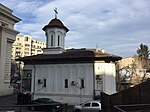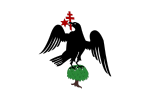Carol Parc Hotel
The Carol Parc Hotel in Bucharest, Romania, is a five star hotel near historical Carol Park. Opened in 2007. It contains one of the largest Murano crystal chandeliers in the world, stretching over four stories tall. Several vaguely important personalities have stayed there so far, including foreign dignitaries, singer Beyoncé Knowles, Deep Purple, Angela Gheorghiu, and Enrique Iglesias. Located in the heart of Bucharest, on Aleea Suter Str. near the historical Carol Park, the hotel resides on one of the city's highest geographic locations, Filaret Hill (named after a late 18th-century metropolitan of the region). The cul-de-sac is named after Suter (Aleea is Romanian for "alley"), a German architect who helped in the planning of the park and parts of the neighborhood, including the symmetrically built Suteer street.
Excerpt from the Wikipedia article Carol Parc Hotel (License: CC BY-SA 3.0, Authors).Carol Parc Hotel
Aleea Suter, Bucharest
Geographical coordinates (GPS) Address Nearby Places Show on map
Geographical coordinates (GPS)
| Latitude | Longitude |
|---|---|
| N 44.418805555556 ° | E 26.092944444444 ° |
Address
Aleea Suter 19
040547 Bucharest (Sector 4)
Romania
Open on Google Maps








